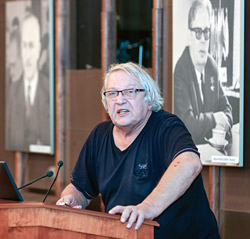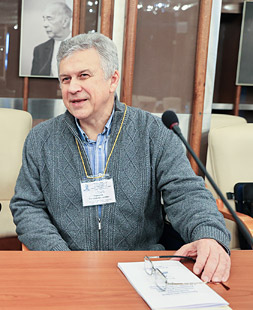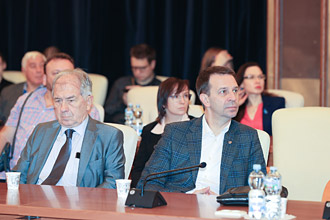
Electronic english version since 2022 |
The newspaper was founded in November 1957
| |
Conferences
Current problems and new technologies in the foreground
(Ending. Beginning in the Issue No. 43.)
 In his report "The epigenetic revolution and its lessons for radiobiologists", A.V.Rubanovich (Vavilov Institute of General Genetics, Russian Academy of Sciences) spoke, among other things, about lost heritability. I asked Alexander Vladimirovich to comment on this problem.
In his report "The epigenetic revolution and its lessons for radiobiologists", A.V.Rubanovich (Vavilov Institute of General Genetics, Russian Academy of Sciences) spoke, among other things, about lost heritability. I asked Alexander Vladimirovich to comment on this problem.
- The whole end of the last century and in the zero years, we dreamed that we would read the entire human genome and be able to explain everything: why one person is predisposed to cancer and the other one is tall. We successfully sequence (sequencing is the establishment of a sequence of nucleotides in DNA), there are sequences (sequencing results) of a new generation, but ... Here, we are absolutely different but our "texts" are the same inside, the difference is only approximately in every thousandth "letter". If you remove every thousandth letter from the novel, you will read and understand it with the same success, but not so with the genome. In general, we have learned to read this "text", but we are able to explain nothing. For instance, schizophrenia has a high heritability of 70-80 percent. We look for nucleotide polymorphisms to which this may be related. We find, little, but we find that this is reproduced in different experiments, yet the effects of a single nucleotide substitution are negligible, we consider the cumulative effect and explain only 0.1 percent of the real heritability! This is what is called lost heritability and this is a very serious problem, for we read the entire text, but could not explain either the variability of traits or their heritability.
Today, there are great expectations for epigenetics, so we talk about the epigenetic revolution. The method of cytosine methylation has been mostly investigated, in a case when it performs as the fifth "letter" (four "letters" are four types of nucleotides that form a DNA chain). At present, biology has changed a lot, there are hundreds of thousands of predictors (forecasters, prognostic parameters), among them there may be purely random relationships and this significance should be recalculated in such a way as to take into account the possibility of random occurrence of effects. When you have a million tests, maybe what you see is random. And the results of methylation (chemical modification of a DNA molecule without changing its very nucleotide sequence) were a shock for me - a clear heritability is visible here. But it rather explains the traces of some kind of exposure, such as smoking, exposure. These traces remain in certain genes for life, so they can be determined quite accurately.
Hero of the Russian Federation Pilot-cosmonaut S.V.Avdeev traditionally participates in Dubna conferences on this topic:
- At present, the preliminary design of the future Russian orbital station ROSS is still underway. This is the period when it is necessary to take into account the results of the work presented at this and other conferences. Despite the fact that we have been flying for many years, these investigations in medicine and biology are necessary.


S.A.Geraskin (All-Russian Research Institute of Radiology and Agroecology, Obninsk) does not participate in the Conference held in Dubna for the first time, either.
- I should say that the Conference was a success. Firstly, there was a Covid period when we didn't meet at all or met online, but here it's completely different. Lack of live communication reduces efficiency. This Conference is special, jubilee, although it is clear that the results are not summed up for all 65 years. New areas become clear and we have new opportunities. This is due to new supercomputers, on which we can calculate what has been previously impossible. Several interesting reports were given that showed how today we can simulate the interaction of ionizing radiation with DNA, with a cell, how to try to transmit it into other levels of biological organization. This is a very interesting area, yet it still has to develop and develop, for at the current level of detail we are not able to complete this chain, but the fact that such attempts have started, it is very essential.
Another trend in many reports is the occurrence of so-called omics technologies. These are molecular technologies, when we can look at the transcriptome, metabolome, we can sequence the genome. These are absolutely amazing things, for we have got an apparatus that allows us to study in detail gene expression (the process during which hereditary information from a gene is converted into RNA or protein) how metabolites shift in a cell depending on different conditions. What are the difficulties of these technologies? The fact is that we obtain an absolutely incredible amount of data that is very hard to cover, to identify a general trend, at the same time it is urgent not to miss anything. We currently work on the development of very special methods that allow us not to miss anything essential in a huge amount of information. These methods are being developed, it happens at present, we currently do this and it is a great happiness that we can participate in it and see the results of our efforts.
In several reports, it was emphasized that epigenetics is an essential topic. In his excellent report, Sasha Rubanovich showed that epigenetics indicates a clear relation that DNA polymorphism research does not reveal. I work with plants. We have obtained unique results for the Chernobyl and Fukushima accidents - we compared the epigenetic effects on pine. We received interesting data that we could not even dream of before - today is an amazing time!


At the last meeting, the responsible secretary of the RAS Scientific Council on Radiobiology V.I.Naydich expressed her deep appreciation and gratitude to the LRB team and Organizing Committee, as well as to LRB Scientific Secretary I.V.Koshlan that ensured the success of the Conference and its sincere atmosphere.
 At the end of the Conference, LRB Scientific Leader, Corresponding Member of the Russian Academy of Sciences, Chairman of the Scientific Council of the Russian Academy of Sciences on Radiobiology E.A.Krasavin said:
At the end of the Conference, LRB Scientific Leader, Corresponding Member of the Russian Academy of Sciences, Chairman of the Scientific Council of the Russian Academy of Sciences on Radiobiology E.A.Krasavin said:
- I wish to thank everyone for participating in our Conference. Organizing it, we intended to bring together specialists that at various times have worked on the development of the Council in order to hold a memorial part of the meeting. Of course, we could no longer invite the founding fathers. The memoirs in the memorial part showed the significance of our science. All the tasks set before the Council have been successfully carried out, normative documents have been developed. We always remember the founding fathers, we know what foundation they laid. In the scientific part of our Conference, we intended to cover various aspects of radiobiology - molecular, genetics, space. It is difficult to cover everything, but we succeeded to do something. The main thing is that we met, talked in person, this is the most precious thing. The youth participated in meetings - this is wonderful, they presented good reports. I think, under current circumstances, our science will develop. We should stand together and improve our cooperation.
And for our weekly, Evgeny Alexandrovich added: "Today, the solution of fundamental issues related to the medical application of new approaches occurring in radiobiology, including for the treatment of neoplasms, has become imminent. A medical accelerator for proton therapy for cancer will operate in Dubna. The prospects for the development of using novel radionuclides - again for the treatment of malignant neoplasms, the further area of producing new radioprotectors - drugs that protect against radiation exposure were also discussed at the Conference. We held further discussion on the development of the space theme. New scientific achievements here should be facilitated by the implementation of the NICA project at JINR that will also work for space.
LRB also does not stand still. As for the problem of implementing long-term manned flights, we together with academicians A.I.Grigoriev and M.A.Ostrovsky, published a strategically essential article in the Bulletin of the Academy of Sciences. It says that at the forefront of these investigations it is necessary to estimate the impact of heavy charged particles of galactic radiation on the central nervous system. As a result of this impact, participants in space flights may be disturbed by such functions as behavioral response, memory and others. We have achieved very interesting results, further work in this area will be carried out, including within the framework of the NICA project. The second area concerns the medical use of ionizing radiation for the treatment of malignant tumors. We have discovered that there is a class of substances that under the action of irradiation, in particular, proton beams, significantly increase the radiosensitivity of cancer cells. This is very important, as it becomes possible to increase the efficiency of irradiation that is essential for promising medical practice."
Olga TARANTINA,
photo by Igor LAPENKO